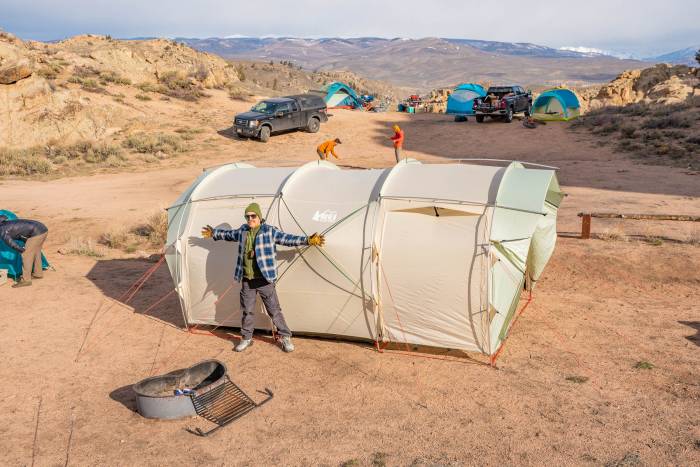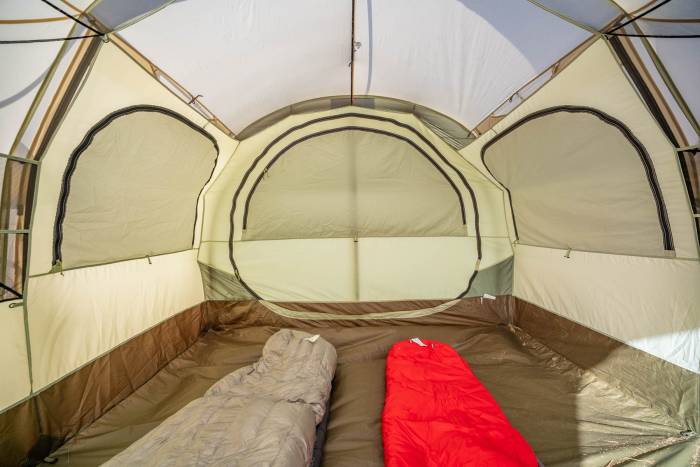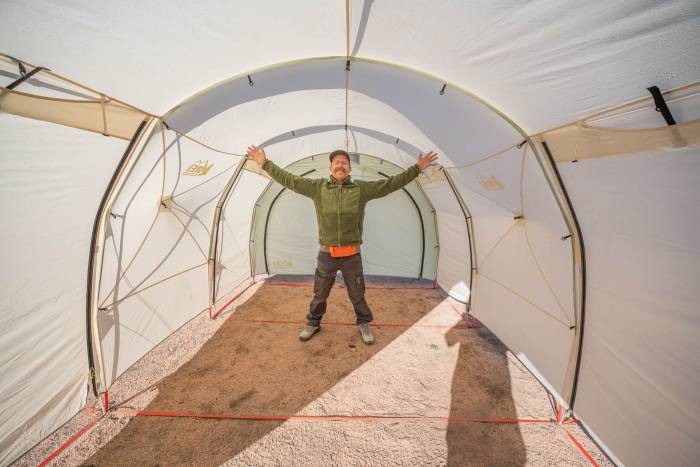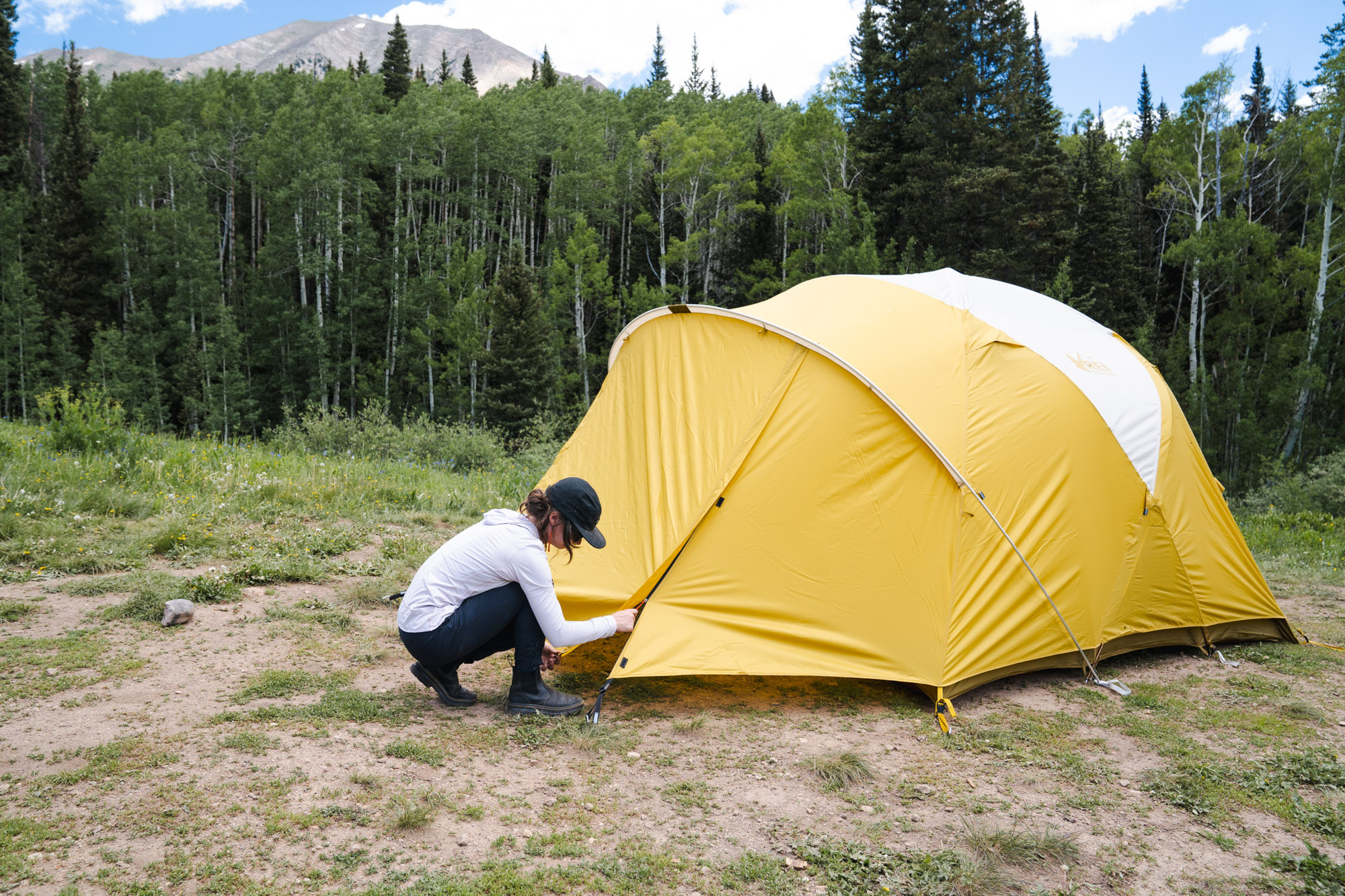The Best Camping Tents of 2025
- Best Overall Camping Tent: MSR Habitude 6
- Best Budget Camping Tent: Kelty Discovery Basecamp 4
- Best Tent for Families: REI Co-op Wonderland X
- Best Tent for Groups and Gear: Mountain Hardwear Bridger 4
- Best Harsh Weather Camping Tent: REI Co-op Base Camp 6
- Most Livable 4-Person Camping Tent: NEMO Aurora Highrise 4P
- Best Crossover Tent for Camping and Backpacking: Mountain Hardwear Mineral King 3
- Floor Area: 83 sq. ft. (120" x 100")
- Weight: 14 lbs.
- Height: 77"
- Footprint Included: No
- Number of Doors: One
- Carry Size: 23" x 10" x 10"
- Seasons: 3-season
- Best For: Large family camping outings where weather might be variable
Pros
- Smart pole geometry and tough fabrics means this tent is built to last
- LED porch light integrated into the tent
- Generous sleeping area
- Rain fly coverage drops low to prevent gusts from sneaking in
- Steep canopy walls
Cons
- Single door means you may have to stumble over tent mates to enter/exit
- Expensive
- Floor Area: 53 sq. ft. (97" x 79")
- Weight: 8 lbs., 8 oz.
- Height: 58"
- Footprint Included: No
- Number of Doors: One
- Carry Size: 23" x 6"
- Seasons: 3-season
- Best For: Casual weekends of car camping, festivals, beach camping
Pros
- Easy and intuitive to set up
- Inexpensive
- Pre-attached guylines
- Storage duffel is easy to stuff and unpack
Cons
- Rainfly isn't full protection
- Fiberglass poles
- Floor Area: 70.5 sq. ft. (100" x 100")
- Weight: 35 lbs., 1 oz.
- Height: 75"
- Footprint Included: No
- Number of Doors: Four
- Carry Size: 27.4" x 14" x 12.8"
- Seasons: 3-season
- Best For: Mondo-sized camping trips with the whole crew
Pros
- Huge tent for four people
- Doubles as a massive shelter for cooking, entertaining, or eating
- Extremely durable
- The sleeping area is very large and protective from the elements
Cons
- Expensive
- Too big for smaller campsites
- Floor Area: 62.5 sq. ft. (96" x 90")
- Weight: 18 lbs., 9.4 oz.
- Height: 68"
- Footprint Included: Yes
- Number of Doors: Two
- Carry Size: 26" x 13" x 13"
- Seasons: 3-season
- Best For: Camping with the whole crew, or bringing along the kitchen sink in gear
Pros
- Vestibules are huge, and can fit entire bikes or coolers if needed
- Many pockets inside the sleeping area and vestibules
- Saloon-style doors open up to easily combine areas
- Simple rope-bag style stuff sack
Cons
- Not the easiest to set up single-handed
- Pretty pricey
- Floor Area: 84 sq. ft. (110" x 110")
- Weight: 20 lbs., 11.5 oz.
- Height: 74"
- Footprint Included: No
- Number of Doors: Two
- Carry Size: 24" x 11" x 11"
- Seasons: 3-4 season
- Best For: All-weather camping where comfort is in high-demand
Pros
- Huge vestibule
- Excellent weather resistance
- Easy to set up
- Compatible with other REI tent accessories such as canopies
Cons
- Heavy at 20 pounds
- Expensive
- Floor Area: 62.5 sq. ft. (100" x 90")
- Weight: 15 lbs., 14 oz.
- Height: 75"
- Footprint Included: No
- Number of Doors: Two
- Carry Size: 25" x 8.5" x 8.5"
- Seasons: 3-season
- Best For: Camping with the whole family, sleeping on cots, and tall parents
Pros
- Steep side walls bumps up livable space
- Fun print on interior floor
- Both doors stow away completely
Cons
- Rainfly doesn't provide 100% coverage
- A little heavier than comparable tents
- Floor Area: 42.5 sq. ft. (90" x 68")
- Weight: 7 lbs., 1.2 oz.
- Height: 48"
- Footprint Included: Yes
- Number of Doors: Two
- Carry Size: 25" x 7"
- Seasons: 3-season
- Best For: Do-it-all camping and backpacking for folks who don't want to have separate tents
Pros
- Compact packed size
- Roll-back rainfly for star viewing
- Spacious twin vestibules
- Amenable to car camping or backpacking
Cons
- Hubbed poles can be finicky
- Not as spacious as other 3-person camping tents
Other Camping Tents to Bed Down In
- Floor Area: 58 sq. ft. (96" x 90")
- Weight: 13 lbs.
- Height: 68"
- Footprint Included: No
- Number of Doors: Two
- Carry Size: 27" x 10" x 10"
- Seasons: 3-season
- Best For: Camping with extra kit to store in the vestibules, or just kicking back beneath the shade
Pros
- Unique second door design
- Plenty of interior storage pocket options
- High interior ceiling
- Relatively lightweight for the space
Cons
- Rainfly isn’t the most intuitive to put on
- Rear door isn’t covered by rainfly
- Floor Area: 59 square feet
- Weight: 14 lbs.
- Internal Height: 62"
- Footprint Included: No
- Carry Size: 27.5" x 9.5" x 9.5"
- Seasons: 3
- Best For: Car campers on a budget looking to upgrade
Pros
- Budget-friendly
- Spacious footprint
- Plenty of headspace
- Quick setup with two people
- Robust tent poles
- Large skylight
Cons
- Minimal protection from driving rain
- Lacking ventilation with the rain cover
- No pull-outs for the broadsides of the tent.
- Drafty in stiff winds
- Floor Area: 82.9 sq. ft. (120" x 100")
- Weight: 17 lbs.
- Height: 76"
- Footprint Included: No
- Number of Doors: Two
- Carry Size: 24.4" x 10.4"
- Seasons: 3-season
- Best For: Any-weather camping where the forecast looks less than optimal
Pros
- Excellent weather protection
- Lighter weight than similar 6-person shelters
- Redesign adds additional vents to the fly
- Close to vertical wall design
Cons
- Rainfly contacts tent mesh in some spots
- Vestibule isn't the largest
- Floor Area: 64 sq. ft. (96" x 96")
- Weight: 20 lbs., 4 oz.
- Height: 84"
- Footprint Included: No
- Number of Doors: One
- Carry Size: 27" x 9" x 9"
- Seasons: 3-season
- Best For: Car camping with a view!
Pros
- Roomy design with plenty of space
- Airy and open with four windows
- Tall internal height
- More budget priced
Cons
- Only one door
- Not great in heavy wind
- Heavier at 20+ pounds
- Floor Area: 85 sq. ft. (120" x 102")
- Weight: 18 lbs.
- Height: 72"
- Footprint Included: No
- Number of Doors: One
- Carry Size: 25.7" x 9"
- Seasons: 3-season
- Best For: Car camping in the desert or busy campgrounds
Pros
- Budget pricing
- Near-vertical walls
- Black-out fly blocks out ambient light
Cons
- Pre-attached poles are good in theory, annoying in practice
- Front vestibule has poor coverage of door
- Fly only goes half-way down tent body
- Floor Area: 58 sq. ft. (92" x 90")
- Weight: 16 lbs., 3 oz.
- Height: 72"
- Footprint Included: No
- Number of Doors: Two
- Carry Size: 26.5" x 16.5" x 6"
- Seasons: 3-season
- Best for: Camping during unsure weather forecasts or in exposed campsites, as well as big group basecamps as a hangout spot
Pros
- Fast fly mode creates a stand-alone sun shelter for hanging out under
- Good amount of headroom
- Easy to assemble DAC hubbed pole design
- Pass-through doors makes it easy to sneak around tent mates
- Near-vertical walls
Cons
- More expensive than similar 4- and 6-person tent options
- Fast fly mode is a bit hard to set up
- Floor Area: 46.8 sq. ft. (83.5" x 80.7")
- Weight: 18 lbs., 1.6 oz.
- Height: 52"
- Footprint Included: No
- Number of Doors: Two
- Carry Size: 28" x 8.7" x 8.7"
- Seasons: 3-season
- Best For: Easy car camping, festivals, or camping at the beach
Pros
- Setup and takedown are a piece of cake
- Keeps out most light for undisturbed sleep
- High waterproof rating on the bathtub floor
Cons
- Low ceiling height
- Small vestibules
- The rainfly can’t be removed, so no stargazing mode
Camping Tent Comparison Chart
| Camping Tent | Price | Floor Area | Weight | Height | Number of Doors |
|---|---|---|---|---|---|
| MSR Habitude 6 | $700 | 83 sq. ft. (120″ x 100″) | 14 lbs. | 77″ | One |
| Kelty Discovery Basecamp 4 | $120 | 53 sq. ft. (97″ x 79″) | 8 lbs., 8 oz. | 58″ | One |
| REI Co-op Wonderland X | $999 | 70.5 sq. ft. (100″ x 100″) | 35 lbs., 1 oz. | 75″ | Four |
| Mountain Hardwear Bridger 4 | $780 | 62.5 sq. ft. (96″ x 90″) | 18 lbs., 9.4 oz. | 68″ | Two |
| REI Co-op Base Camp 6 | $549 | 84 sq. ft. (110″ x 110″) | 20 lbs., 11.5 oz. | 74″ | Two |
| NEMO Aurora Highrise 4P | $400 | 62.5 sq. ft. (100″ x 90″) | 15 lbs., 14 oz. | 75″ | Two |
| Mountain Hardwear Mineral King 3 | $375 | 42.5 sq. ft. (90″ x 68″) | 7 lbs., 1.2 oz. | 48″ | Two |
| The North Face Wawona 4 | $450 | 58 sq. ft. (96″ x 90″) | 13 lbs. | 68″ | Two |
| REI Co-op Campwell 4 | $229 | 59 sq. ft | 14 lbs. | 62″ | One |
| Marmot Limestone 6-Person Tent | $529 | 82.9 sq. ft. (120″ x 100″) | 17 lbs. | 76″ | Two |
| Eureka Copper Canyon LX 4-Person Tent | $270 | 64 sq. ft. (96″ x 96″) | 20 lbs., 4 oz. | 84″ | One |
| Coleman Skydome Darkroom 6-Person Tent | $200 | 85 sq. ft. (120″ x 102″) | 18 lbs. | 72″ | One |
| Big Agnes Bunk House 4 | $600 | 58 sq. ft. (92″ x 90″) | 16 lbs., 3 oz. | 72″ | Two |
| Decathlon Quechua 2 Second Easy Camping Tent | $349 | 46.8 sq. ft. (83.5″ x 80.7″) | 18 lbs., 1.6 oz. | 52″ | Two |

How We Tested the Best Camping Tents
Our Testing Process and Testing Grounds

Our Expert Testers

Buyer’s Guide: How to Choose a Camping Tent
Camping Tent Types
High-End Camping
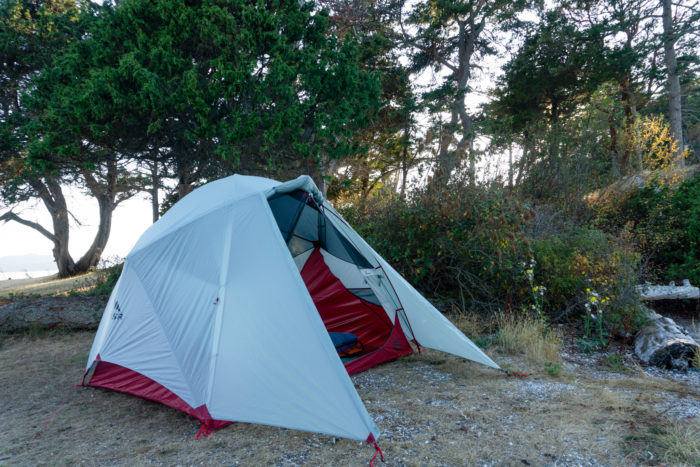
Budget Camping

Crossover Camping

Weather Resistance

Seasonality Ratings
- 3-Season Tents: 3-season tents (meaning spring, summer, and fall) are your lightest-duty tents, and will employ lightweight materials in order to keep overall bulk down, as well as improve ventilation. Typically, the tent body will be nearly or entirely mesh, and mated to a bathtub floor. These tents also tend to be more suited to family use, and will often be taller and sport near-vertical walls. These designs are less aerodynamic, and more prone to bending under gusts of wind. Finally, most 3-season tents will use a rainfly that isn’t full coverage, and may only extend over windows and doors, instead of all the way to the ground. In fair weather, this is no issue, but it is something to keep in mind for less-appealing weather conditions.
- 3/4-Season Tents: Bulking up on weather resistance, 3/4 or 3.5-season tents are similar to 3-season tents material-wise, but in design, they often are more weather-ready, usually employing dome shapes. Rain flies will also go all the way to the ground, forming vestibules where you might store your backpacks during an overnight rain.
- 4-Season Tents: This is the realm of winter, mountaineering, and hunting tents, where weather resistance is in high demand and a tough structure is needed. Four-season tents are almost exclusively double-wall designs, and often shaped in domes or tunnels to better survive the wind. They will also sport many guylines to adequately support the tent, and thicker tent poles and materials to resist wind-driven rain and snow.

Capacity and Floor Area

Construction Materials

Coating

Fabrics Are Also Measured in Grams Over a Square Meter
Comfort



Ease of Use

Extra Features

Other Considerations and Taking Care of Your Tent

Poles

Zippers
Footprint
Weight and Packed Size

Camping Gear: What Else Do You Need?

Price & Value
Budget
Mid-Tier
Premium

Frequently Asked Questions
The best family camping tent depends on your outdoor goals. In general, most families appreciate having more room and the ability to stand comfortably.
The MSR Habiscape 4 Tent has earned high marks from our family camping testers. If you regularly camp in adverse weather (hello, spring in Colorado), it’s worth considering a slightly smaller and more durable tent.
The best camping tent brand depends largely on your personal needs and budget.
For a premium tent that can withstand the weather, MSR consistently delivers. If you’re looking for maximum space and flexibility, the Eureka Copper Canyon is a favorite with families. And for a budget-friendly option that is built to last, check out Kelty.
If you plan to camp regularly, it is worth it to invest in a higher-quality tent. The extra expense means sturdier poles, waterproof seams, and generally an easier setup. If budget is a major concern, don’t let that stop you from getting outside.
We’ve consistently been impressed with the budget-friendly options from Kelty. The Kelty Discovery Basecamp 4 costs just $120 and offers plenty of room.
Quality tents are waterproof. But if you find yourself camping in an absolute downpour, hanging a tarp can provide extra protection and comfort.
It’s important to tie it up well so the wind isn’t a concern and to be sure that it isn’t touching the tent. In addition to creating an extra tent porch, a tarp is great for protecting your camp kitchen.

Once you’ve located your camp zone, then consider where you might like to set up camp for the night. While campgrounds take the guesswork out of the equation, public-use land such as BLM land leaves the choice up to you. Micro-landscape features will have a big impact on your overall enjoyment, so be mindful of the following:
Ridgelines tend to catch more wind overnight, and setting up camp here can be asking for a windy evening. And while setting up your tent right next to a lake may appeal to many, these thoroughfares to water are important to local wildlife, and should be left free to not impede their access.
Take a look at the landscape above your potential campsite as well, as nobody wants to set up underneath a rock-fall area. Camping on durable surfaces is the second Leave No Trace principle, and shouldn’t be taken lightly.
And finally, consider your space from others enjoying the wilderness. You likely came out here to enjoy some quiet, and they probably did as well!
While there are many different styles of tent available today, each has a better use profile and ideal adventure to use them on. When it comes to camping tents, the most popular shape will be a dome-style tent. This is because of ease of use, as well as the trade-off in canopy headroom to the overall complexity.
Some tents, like the REI Co-op Wonderland X, make use of a tunnel-style structure. These tents often boast more headroom overall, but will suffer some during high winds. For this reason, it’s important to properly guyline out a tunnel-style tent.
Other tents still, like the Eureka Copper Canyon 4 Tent or Decathlon Quechua 2 Second Tent, employ a collapsible style of integrated poles that forms a rigid structure once assembled. These tents are often among the easiest to use, but also the weakest overall, as any strong force against their poles could collapse them.

The Best Camping Mattresses of 2025
From packable sleeping pads to ultracomfortable air beds, we tested and found the best camping mattresses and sleeping pads to fit every adventure and budget.

The Best Camping Sleeping Bags of 2025
From versatile camping bags to wallet-friendly picks, we’ve found the best sleeping bags for every use and budget.







